When you’re considering bringing a parrot into your apartment, the two biggest concerns are limited space and potential noise complaints from the neighbors.
So your best bet is to go for some of the small-sized species since their cage setup takes a lot less space and they’re not going to be as loud as larger parrots.
But there’s more to think about, like the mess they make, especially if the parrot sheds dust, and you’ll want to make sure they have a safe area to fly around since most birds don’t like being cooped up in their cages all the time.
Quick Navigation
Best Parrots For Apartments
Here are the best parrots for apartments that you can keep:
Budgerigar
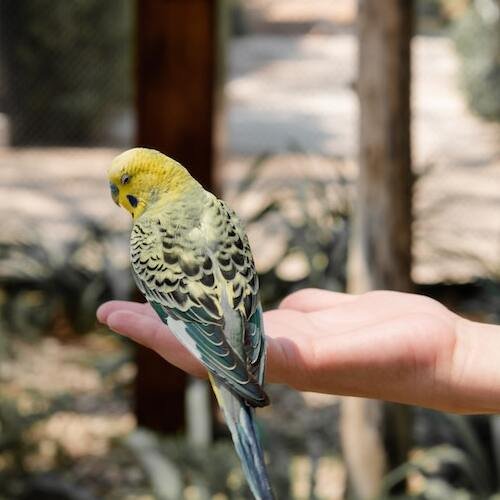
Affectionate, talkative, and absolutely charming, the budgerigar is everything you ask for in a companion parrot. Budgies are all-around great pet birds that adapt well to any kind of living arrangement, which is probably why they are such popular pets.
Budgies cannot vocalize very loudly, which is good news for the neighbors. However, that does not mean that budgies are not vocal. Their chatter and chirps are frequent but never reach disturbing levels of loudness.
Budgies have a unique set of characteristics that are rarely found together in parrots. They are both quiet and good talkers. Budgies can learn words, phrases, and different sounds easily because they have a natural talent for it.
For a single budgie, an 18 x 18 x 18 inches cage size will be appropriate, giving them enough room to move freely. Budgies are highly social, so you need to spend some quality time with them and also provide them be adequate out-of-cage time.
Parrotlet

A miniature version of the true parrots, Parrotlets measure just over 5 inches in length. They are smaller than budgies and lovebirds and do not take up much room in the house.
Because of their, extremely small size, they can’t vocalize with the vigor other parrots do. They communicate through soft chattering, tweeting, and chirping sounds. Parrotlets can also mimic words and sounds, though they do not have the best clarity of speech.
Parrotlets are very active and feisty birds and therefore require a roomy cage where they can zip around from one end to the other. The recommended cage size for a parrotlet is 24 x 18 x 18 inches. The cage should also have plenty of toys and other enrichment to keep them busy.
Lovebirds
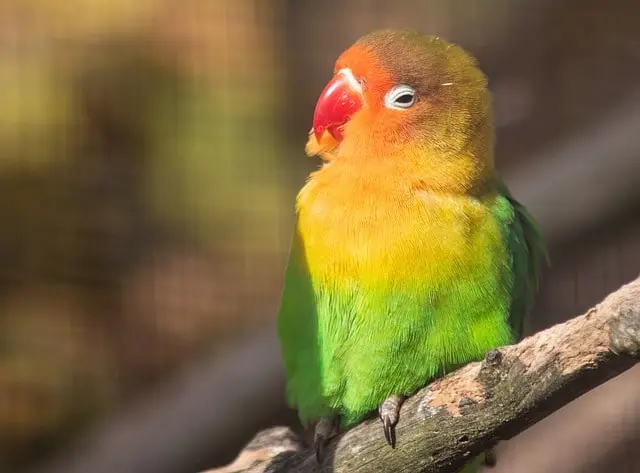
A little mischievous, but immensely cute, lovebirds are small parrots who make their presence known through their playful antics and sweet vocaliations.
Lovebirds have strong vocals for their size and can chatter up a storm. They are noisy compared to other small parrots but their loudness is still within the accepted limits. Their tuneful chirps and whistles are pretty frequent but pleasant to the ears.
Single lovebirds can live happily in a cage of 18x18x18 inches. They love playtime and interaction with their owners and a good variety of toys will keep their beaks busy throughout the day.
Many people think that lovebirds need to be kept in pairs. This is not true and if you live in an apartment, you should not get a second lovebird. Two lovebirds can raise the noise level quite high as they communicate with each other constantly.
Cockatiels
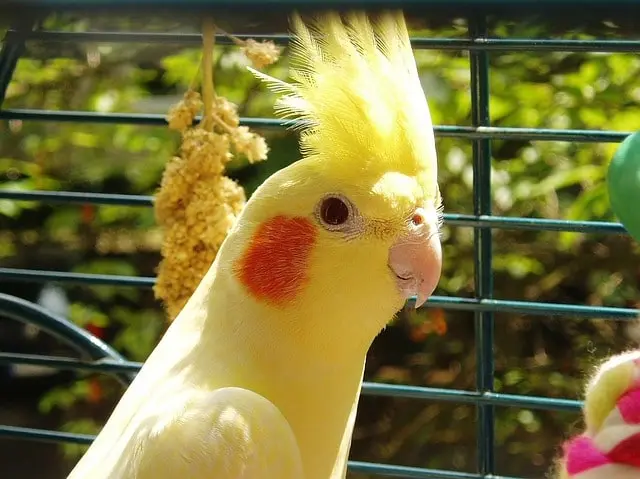
With a beautiful crest, orange cheek patches, and a friendly personality, cockatiels make adorable pets. Cockatiels have an amicable disposition and are relatively easy to tame. They bond with their owners and can become loving pets.
Cockatiels can be kept in apartments without the neighbors knowing about them. They are mostly quiet birds only vocalizing in chirps and whistles.
Sometimes, cockatiels can also make screaming noises when they are excited, angry, or lonely. It is sometimes referred to as a scristle (a combination of a scream and a whistle). However, as other melodic sounds cockatiels make, it is too loud or screechy.
Female cockatiels are known to be less noisy than males and can be a better choice for someone who prefers quiet in the house.
Cockatiels are quite active around the house and like to fly around. A cockatiel cage should be at least 20 x 20 x 24 inches to give them an open enough space.
A major drawback of cockatiels as an apartment bird is that they are dusty birds. Cockatiels have powder-down feathers and shed loads of dander every day.
If you wish to keep a cockatiel as a pet, you should take into account the allergy concerns of yourself and other family members. You may also need to get an air purifier to maintain air quality and the cage may require more frequent cleaning as well.
Pionus Parrot
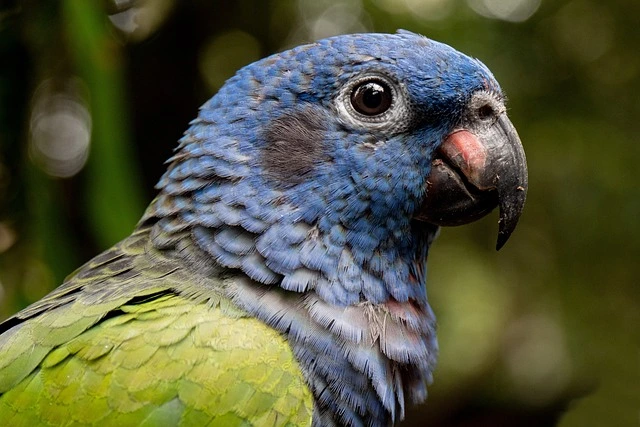
If you’re looking for a slightly larger bird, Pionus parrots can be a good candidate for apartment living. Pionus parrots are medium-sized birds that measure 10-12 inches.
Their easygoing nature and soft-spoken voice make them a good apartment bird. Pionus parrots are quiet for the most part, but they can have loud spurts.
Pionus parrots are low-energy birds and prefer not to fly inside their cages or move too much. They will not make a peep or disturb you, but simply hang around to keep you company.
They are also very loving birds and make excellent family pets. White-capped Pionus and Blue-headed Pionus are the most commonly kept species of Pionuses.
A 24 x 24 x 30 inches cage is roomy enough for pionus parrots. Pionus parrots tend to be more independent than some of the other social parrots. However, they are social birds and require attention and love from their owners.
Senegal Parrot
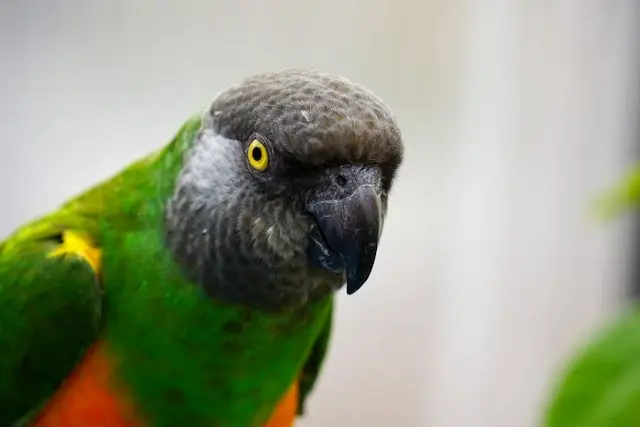
The Senegal parrot is a fun-loving bird full of character and energy. They are known for their goofy nature and being an entertainer.
Senegal parrots love spending time with their human companions and are highly trainable. However, they have the tendency to become one-person birds, which means they might not like everyone in your family.
Senegals are not screamers, which is why they are great for apartments. Their vocal repertoire consists of whistles and clucking sounds.
Senegal parrots are on the smaller side, so they don’t take up too much space. A cage size of 20 x 20 x 28 inches is appropriate for these birds, although you should routinely let them out of their cage for training and exercise.
Meyer’s Parrot

Meyer’s Parrots are easygoing and even-tempered birds who like to sit quietly on their perch. But that does not mean they’re boring. They are social birds that enjoy the company of different people, which makes them suitable for a family setting.
Meyer’s parrots communicate in gentle whistles, squeaks, and clicking sounds. They rarely scream, but when they do, they have high-pitched squeals. But still, it is not as loud as a conure or other loud parrot.
A minimum cage size for your Meyer’s parrot is 20 x 20 x 24 inches, which should not take up much space in your apartment. While Meyer’s parrots are relatively low maintenance, all birds require attention and ample time with their owners to stay happy.
Bourke’s Parakeets

The Bourke’s parakeet is a gentle and mellow bird both in terms of vocalizations and personality. They are among the quieter species of parrots and usually don’t vocalize any more than a few soft chirps during the day.
While they are quiet most of the day, they become slightly more vocal at sunset as they are a semi-nocturnal species. This is why they are also referred to as the sundown parakeet.
Bourke’s parakeets aren’t as popular as some of the other small parrots, which is in part because they lack personality. While these birds do bond with their owners and can be affectionate, they are not very enthusiastic.
A cage size of 20 x 20 x 28 inches is ideal for the Bourke’s parakeet. They do like to fly in their cage and toys are also essential to keep them busy and entertained.
Barred Parakeets
Another small parakeet on the list is the barred parakeet, also known as the Lineolated parakeet. These birds have a calm temperament and often communicate in soft chatter and murmurs. They are known to have shrill flock calls, but due to their size, it is not a concern in terms of loudness.
Barred parakeets are laid back, easily getting along with other family members and fitting into any apartment. They enjoy walking on the floor more than they like flying, so you’ll often see them pacing in their cages.
Barred parakeets do need very little space so an 18 x 18 x 24 inches cage should suffice. They will be happy living in this cage provided you give them regular interaction and plenty of toys.







